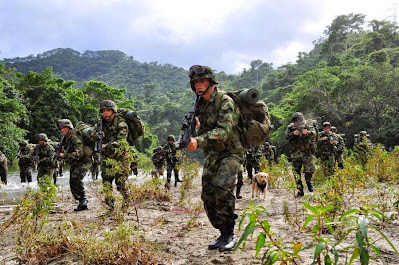It’s been expressed here before that I generally go along with the ‘communicate rather than exterminate’ stance when it comes to dealing with human enemies.
This line is practically sacrosanct when the other side is showing a willingness to compromise.
This line is practically sacrosanct when the other side is showing a willingness to compromise.
What’s more, when you have a conflict that has been ongoing for more than a couple of generations, showing scant signs of progress on either side, engaging in talks seems not only prudent but unavoidable.
That was basically the case when Colombia’s latest peace talks got underway over two years ago.
However, to say they’ve hit a stumbling block or two over the last few weeks and months is putting it mildly. You could say that this was always a strong possibility given that both the Farc and government forces have remained largely on the offensive; that is to say, there has been no meaningful ceasefire.
The rebels' (Farc et al.) strategy of kidnapping not only combatants but also civilians continued.
Yet, the talks also carried on regardless. Well, they did until the Rubicon – or more precisely a river in the Chocó department – was crossed by Farc in terms of what the government saw as permissible acts throughout this whole process: That being the kidnapping of army general Rubén Darío Alzate.
His release after two weeks in captivity and subsequent resignation have meant the passage is clear for the peace talks to move forward again, resuming as they will on 10 December. (The fact that the general in question has admitted he and his companions breached safety protocols in a known red zone in the country is also somewhat of a mitigating factor; “one shouldn’t 'dar papaya', General.”)
That being so, the pessimism that has grown in many quarters over the direction these discussions are taking is understandable.
OK, agreement, we’ve been told, has been reached in both land reform and the rebel’s future political participation should a final deal be sealed, while decent progress seems to have been made on victims’ rights.
 |
| Both parties to the Colombian peace talks remain in combat. (Photo from Twitter.) |
However, to say they’ve hit a stumbling block or two over the last few weeks and months is putting it mildly. You could say that this was always a strong possibility given that both the Farc and government forces have remained largely on the offensive; that is to say, there has been no meaningful ceasefire.
The rebels' (Farc et al.) strategy of kidnapping not only combatants but also civilians continued.
Yet, the talks also carried on regardless. Well, they did until the Rubicon – or more precisely a river in the Chocó department – was crossed by Farc in terms of what the government saw as permissible acts throughout this whole process: That being the kidnapping of army general Rubén Darío Alzate.
 |
| Saying goodbye: General Alzate. (Picture from Twitter.) |
That being so, the pessimism that has grown in many quarters over the direction these discussions are taking is understandable.
OK, agreement, we’ve been told, has been reached in both land reform and the rebel’s future political participation should a final deal be sealed, while decent progress seems to have been made on victims’ rights.
These are three of the six key areas of the talks. The other elements are drug trafficking, rebel disarmament and the implementation of the peace deal itself.
The most infamous of the above sextet, drug trafficking, could no doubt prove to be another major barrier, as mentioned in these pages before.
In that regard, President Juan Manuel Santos caused a stir of late by suggesting drug dealing could be made a political offence and not a criminal one. For him to publicly say it seems to imply that it is being looked at as a potential sweetener for Farc members involved in the trade, however exactly it would play out in practice.
Needless to say, in a country that has suffered more than most due to the illegal narcotics business, not everybody is waxing lyrical about such a possibility.
On a broader, what you might call more abstract scale, there is also the question of who and/or what is Farc?
The most infamous of the above sextet, drug trafficking, could no doubt prove to be another major barrier, as mentioned in these pages before.
 |
| Chocó: Beautiful, but with dangers. |
Needless to say, in a country that has suffered more than most due to the illegal narcotics business, not everybody is waxing lyrical about such a possibility.
On a broader, what you might call more abstract scale, there is also the question of who and/or what is Farc?
In other words, are those doing the guerrilla group’s negotiating in Havana representative of a unified body? It’s difficult to believe they are. But at the very least they represent some warring faction that is tinkering with the possibility of changing its ways.
This process, of course, was always going to be a long one; only the utterly negative or ludicrously positive thought otherwise.
The only certainty, for now, is that there are set to be many more twists and turns before war-weariness wins the day.
This process, of course, was always going to be a long one; only the utterly negative or ludicrously positive thought otherwise.
The only certainty, for now, is that there are set to be many more twists and turns before war-weariness wins the day.
No comments:
Post a Comment